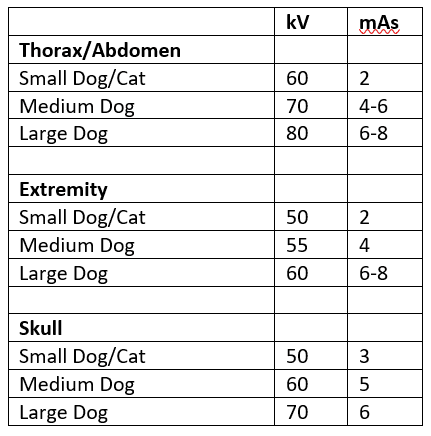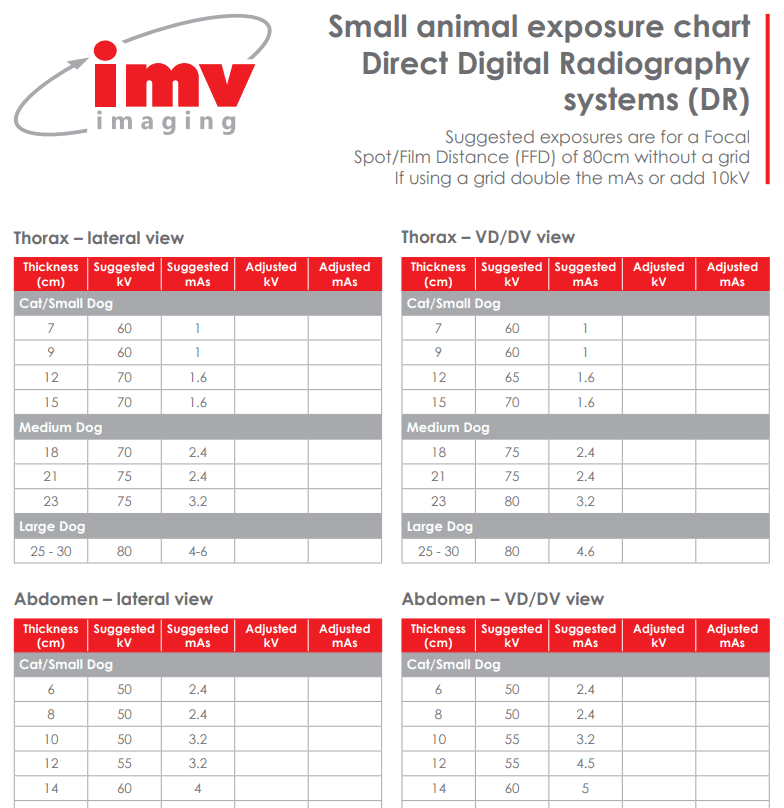Why use X-ray exposure charts?
24 October 2012
Why have a chart?
A good quality exposure chart is one of the most important tools to help you achieve high quality radiographs and reduce the number of repeated X-rays that you take.
We all know that repeating X-rays is annoying, and a waste of both time and money, and can be very frustrating when time is limited, especially with unwell animals.
By having a good exposure chart that is easy to refer too and simple to use you can greatly reduce the number of repeated exposures and make taking x-rays simpler and more fun!
Every X-ray generator is slightly different, and the distance it is used at is a major factor too, which is why it is important to know what to change when setting up your exposure chart, and what to look at on the resulting images to enable you to tweak the chart to best suit your system.
We have provided a selection of exposure charts for Film screen systems, Computerised Radiography (CR) and Direct Digital (DR) systems, at a range of distances and with some minor changes if you have a different generator, and these can be used by everyone to help improve the quality of your radiographs.
Makes life easy
Historically many practices have relied on looking back through their X-ray book to find a similar sized dog/cat, and then hoping that the right anatomy was X-rayed, and using the setting before.
This sadly can be a bit hit and miss, and relies on the recorded exposure being accurate and the dog having been a similar build, as after all a 20Kg Labrador and a 20Kg beagle are going to need different setting for a thoracic radiograph. Also if there has been no comment left as to how good the exposure was you can end up copying a bad exposure.
Alternatively the Santes rule can be used to calculate the kV by following this equation
kVp=(2x thickness of body part in cm) + (the distance from the x-ray tube in inches)
You then also need to have a guideline mAs for each body region.
For example for an extremity on 200 speed film some people suggest an mAs of 2.5 and for a thorax 5mAs
This has been found to be a useful technique to start building an exposure chart from, but doesn’t always take into account different densities of tissues in different body regions and can take time to work out if done for each patient.
Instead having an easy to read exposure chart make life much easier!
Most are based on selecting the body part that you want to radiograph and then the thickness of that body part.
The reason for looking at these two things is simple. You need different kV and mAs for a 10 cm thick thorax than you do a 10cm thick skull, as the skull is obviously denser and requires a higher kV to penetrate it. If you try to use the same setting for both you won’t get the best possible images.
Examples
Here are two examples of exposure charts, and hopefully you can easily see which one is more help for working out the best exposure factors to use.
Example 1

As you know a thorax and an abdomen ideally need different settings as the Thorax contains a lot more air and less soft tissue than an abdomen. The first example is very basic, and this means you haven’t got the level of detail that you need to accurately set exposure settings.
Also a Pelvis ideally need more kV to adequately penetrate through it, in comparison to the abdomen, where you want to be able to see your organs and thus use a lower kV and higher mAs.
Example 2

This chart divides the body into regions and then thicknesses, as well as having gaps to add altered exposures, to help you customise to your specific system.
This is because most generators are slightly different, and being able to adjust the chart to your own preference enables you to get the most from your X-ray system.
The reason we haven’t added grids onto this exposure chart is that without knowing the grid ratio you cannot work out the required exposure, so instead we have left gaps for you to add your amended exposures.
The same rules apply for all types of radiography system, and whilst Computerised and Direct digital systems are normally more forgiving than film, to get the best from any radiograph a good set of settings is vital.
A slight over exposure will give you a better quality image than an under exposed image, but it is always best to aim to get as close to
Fine Tuning
As I mentioned earlier, every X-ray set up tends to be slightly different so it can be worth fine tuning any exposure chart to get the very best from it.
In later blogs I will go into greater depth about how kV and mAs affect your radiograph.
